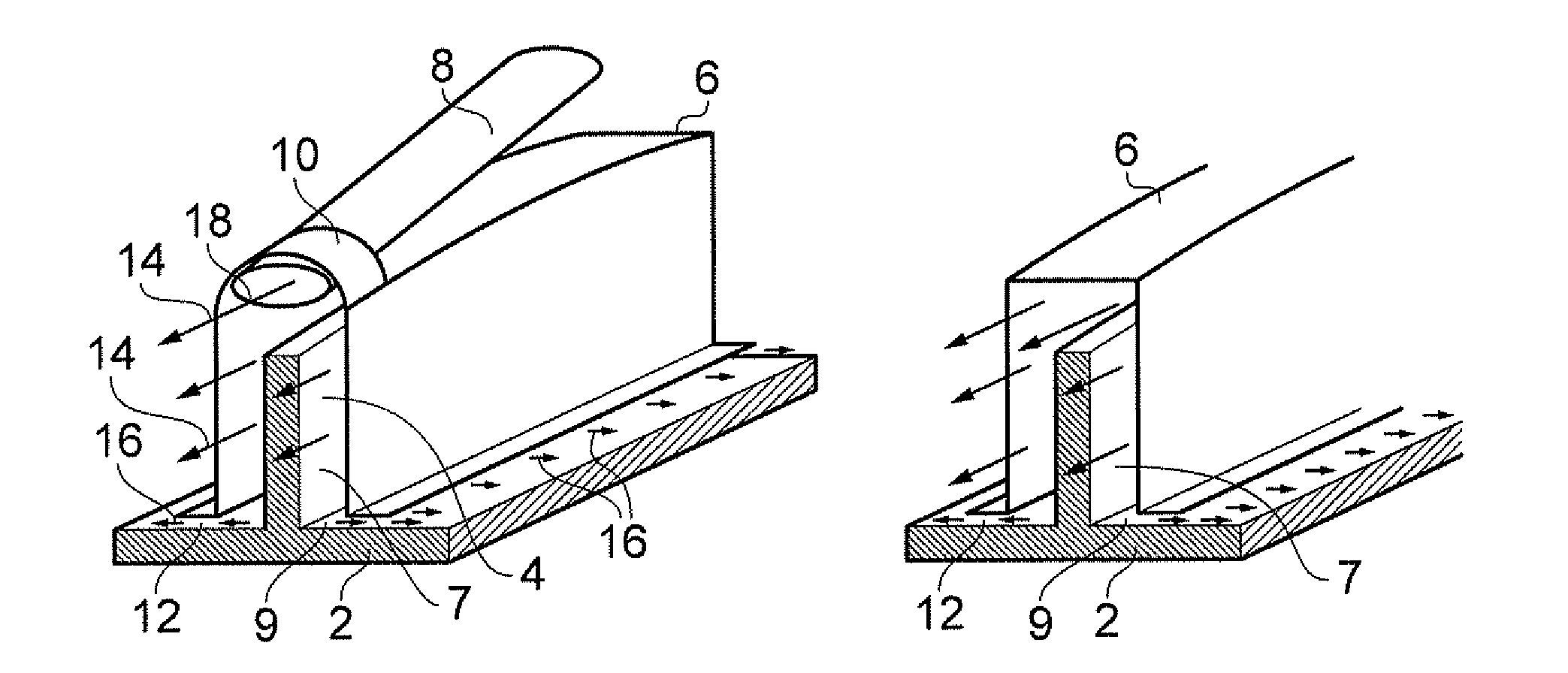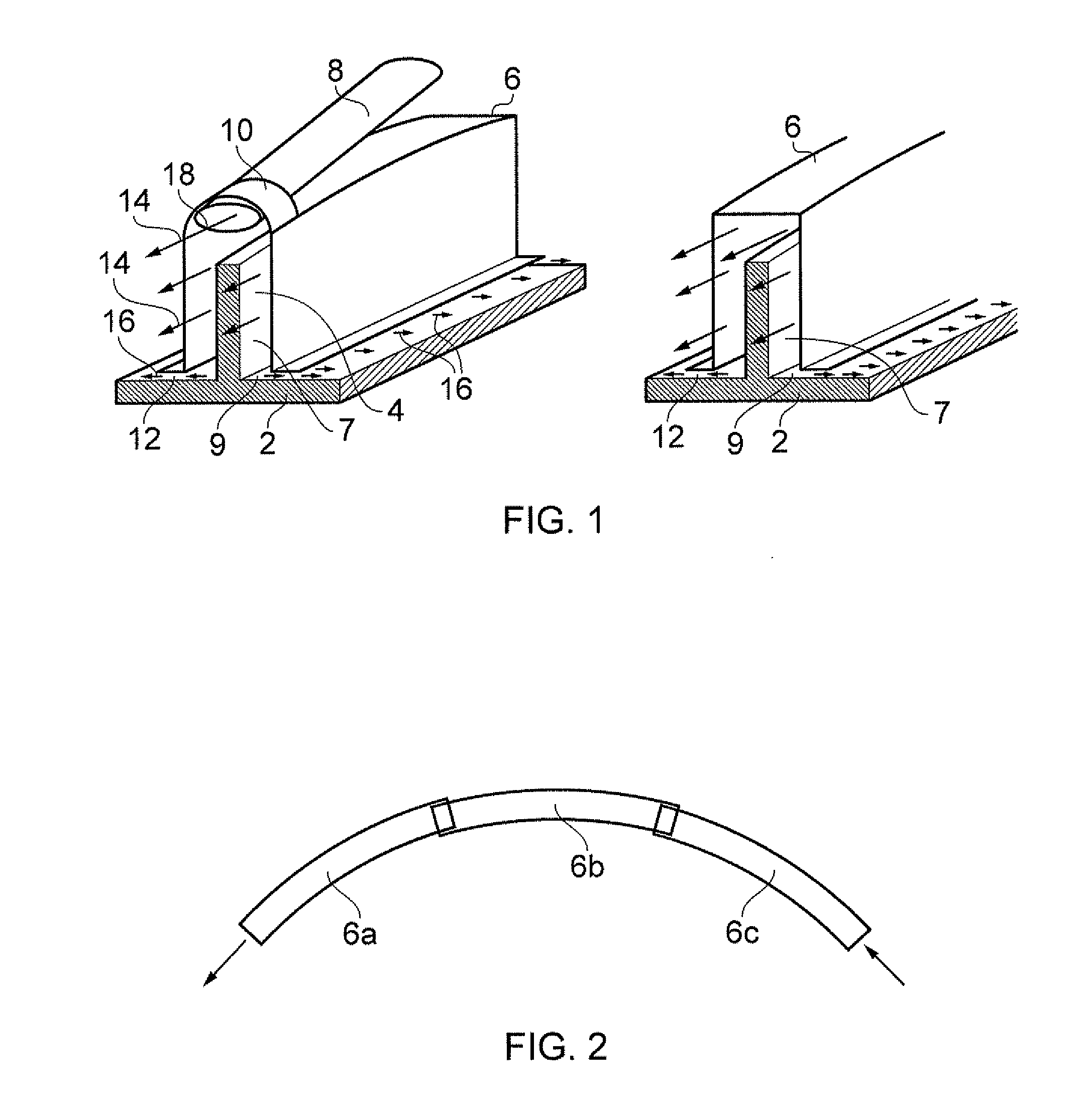[0008]The
thermal control system according to the present invention has a simple configuration, therefore reducing the risk of malfunction, as well as cost. Cooling air may be provided directly onto the casing or, if present, each thermal control ring from a
high pressure source such as a fan or compressor associated with the turbine, and evacuated or leaked through a circumferential gap. If the turbine forms part of a gas turbine engine, the
high pressure source may be the fan or compressor which also forms part of the gas turbine engine, and which is in flow communication with the turbine. The pressure differential between the inside and the outside of the circumferential flow chamber may be very low, reducing the leakage and thereby improving efficiency of cooling. Due to the low pressure differential, the wall of a circumferential flow chamber may be moulded of a thin, light material, such as
metal foil, and the wall may be made of overlapping sections of material. Furthermore, the system is flexible, and may be readily applied to turbines of differing sizes and power, which have differing operational cooling requirements.
[0009]Embodiments of the invention can provide an efficient system for controlling the blade clearance of turbine machinery, which is simple and reliable, cheap and wherein the amount of air bled from the high-pressure portion of the turbine machinery can be tightly controlled.
[0015]The thermal control rings of the
thermal control system according to the invention may have various shapes. For example, the cross-section of the thermal control rings may be rectangular, triangular, angled, dented, forked, or of any other shape. Different shapes of thermal control rings may be used to improve the thermal exchange between a thermal control rings and the thermal fluid, as well as to influence the flow of the thermal fluid within the space between the circumferential chamber and the thermal ring.
[0016]In embodiments of the invention, a circumferential flow chamber may narrow in cross-section, in the direction of the flow of the thermal fluid, from a position where a connection to a duct is provided. This can help to ensure even flow of the thermal fluid throughout a circumferential chamber. At the
injection point, the area of the cross-section of the circumferential chamber would be in proportion to the sum of the entrained fluid flow and the injected fluid flow. The area may then linearly reduce in the flow direction, such that it is in proportion to the entrained flow just before the next
injection point. With this setup, the pressure differential within different sections of the circumferential chamber may be reduced to a minimum, which ensures even flow throughout the circumferential chamber.
[0017]The thermal fluid, which is injected into the circumferential chambers of the
thermal control system according to the invention may be preferably air provided from a high pressure section of the turbine machinery, such as a fan or compressor associated with the turbine. The thermal ducts of the
thermal control system may lead from the high pressure part of the turbine to the injection points of the circumferential chambers. This can help ensure that the
temperature control of the turbine casing is in line with the
internal temperature of the turbine.
[0018]A circumferential chamber wall of the thermal
control system for a turbine casing according to the present invention may be made of an insulating material. This material may be a light malleable
metal sheet, which can be easily moulded into the required form. It may also consist of two
layers of
metal sheets comprising a gap between them, to improve insulation. It is advantageous if a circumferential chamber wall has good insulating properties, in order to ensure that thermal exchange occurs predominantly between the thermal fluid and the thermal control ring(s), and that as little heat as possible is exchanged between the thermal fluid and the inside of the turbine.
 Login to View More
Login to View More  Login to View More
Login to View More 









